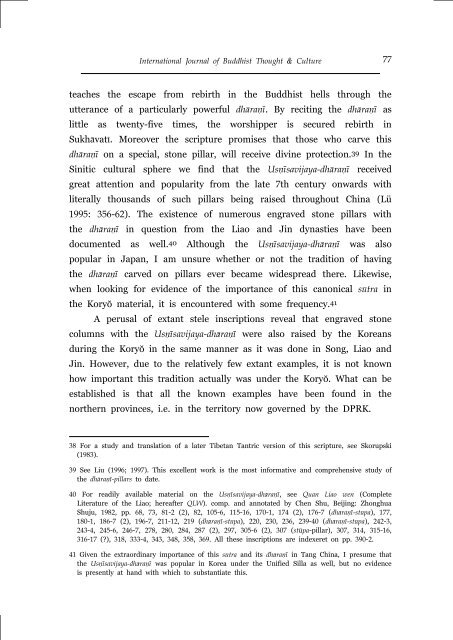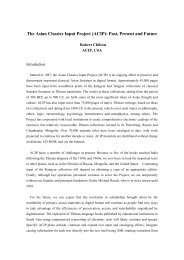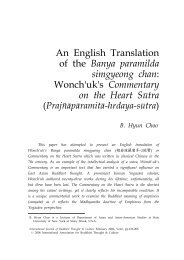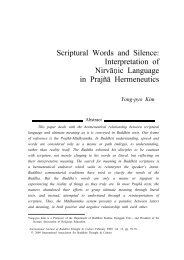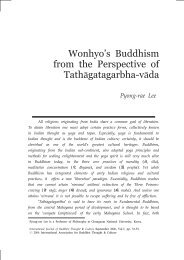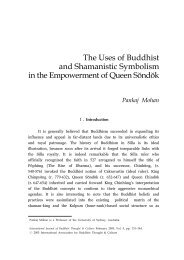Esoteric Buddhism under the KoryÅ in the Light of ... - Buddhism.org
Esoteric Buddhism under the KoryÅ in the Light of ... - Buddhism.org
Esoteric Buddhism under the KoryÅ in the Light of ... - Buddhism.org
You also want an ePaper? Increase the reach of your titles
YUMPU automatically turns print PDFs into web optimized ePapers that Google loves.
International Journal <strong>of</strong> Buddhist Thought & Culture 77<br />
teaches <strong>the</strong> escape from rebirth <strong>in</strong> <strong>the</strong> Buddhist hells through <strong>the</strong><br />
utterance <strong>of</strong> a particularly powerful dh2ra!6. By recit<strong>in</strong>g <strong>the</strong> dh2ra!6 as<br />
little as twenty-five times, <strong>the</strong> worshipper is secured rebirth <strong>in</strong><br />
Sukh2vat6. Moreover <strong>the</strong> scripture promises that those who carve this<br />
dh2ra!6 on a special, stone pillar, will receive div<strong>in</strong>e protection. 39 In <strong>the</strong><br />
S<strong>in</strong>itic cultural sphere we f<strong>in</strong>d that <strong>the</strong> Us!6savijaya-dh2ra!6 received<br />
great attention and popularity from <strong>the</strong> late 7th century onwards with<br />
literally thousands <strong>of</strong> such pillars be<strong>in</strong>g raised throughout Ch<strong>in</strong>a (Lü<br />
1995: 356-62). The existence <strong>of</strong> numerous engraved stone pillars with<br />
<strong>the</strong> dh2ra!6 <strong>in</strong> question from <strong>the</strong> Liao and J<strong>in</strong> dynasties have been<br />
documented as well. 40 Although <strong>the</strong> Us!6savijaya-dh2ra!6 was also<br />
popular <strong>in</strong> Japan, I am unsure whe<strong>the</strong>r or not <strong>the</strong> tradition <strong>of</strong> hav<strong>in</strong>g<br />
<strong>the</strong> dh2ra!6 carved on pillars ever became widespread <strong>the</strong>re. Likewise,<br />
when look<strong>in</strong>g for evidence <strong>of</strong> <strong>the</strong> importance <strong>of</strong> this canonical s^tra <strong>in</strong><br />
<strong>the</strong> Koryŏ material, it is encountered with some frequency. 41<br />
A perusal <strong>of</strong> extant stele <strong>in</strong>scriptions reveal that engraved stone<br />
columns with <strong>the</strong> Us!6savijaya-dh2ra!6 were also raised by <strong>the</strong> Koreans<br />
dur<strong>in</strong>g <strong>the</strong> Koryŏ <strong>in</strong> <strong>the</strong> same manner as it was done <strong>in</strong> Song, Liao and<br />
J<strong>in</strong>. However, due to <strong>the</strong> relatively few extant examples, it is not known<br />
how important this tradition actually was <strong>under</strong> <strong>the</strong> Koryŏ. What can be<br />
established is that all <strong>the</strong> known examples have been found <strong>in</strong> <strong>the</strong><br />
nor<strong>the</strong>rn prov<strong>in</strong>ces, i.e. <strong>in</strong> <strong>the</strong> territory now governed by <strong>the</strong> DPRK.<br />
38 For a study and translation <strong>of</strong> a later Tibetan Tantric version <strong>of</strong> this scripture, see Skorupski<br />
(1983).<br />
39 See Liu (1996; 1997). This excellent work is <strong>the</strong> most <strong>in</strong>formative and comprehensive study <strong>of</strong><br />
<strong>the</strong> dh2ra!6-pillars to date.<br />
40 For readily available material on <strong>the</strong> Us!6savijaya-dh2ra!6, see Quan Liao wen (Complete<br />
Literature <strong>of</strong> <strong>the</strong> Liao; hereafter QLW). comp. and annotated by Chen Shu, Beij<strong>in</strong>g: Zhonghua<br />
Shuju, 1982, pp. 68, 73, 81-2 (2), 82, 105-6, 115-16, 170-1, 174 (2), 176-7 (dh2ra!6-st^pa), 177,<br />
180-1, 186-7 (2), 196-7, 211-12, 219 (dh2ra!6-st^pa), 220, 230, 236, 239-40 (dh2ra!6-st^pa), 242-3,<br />
243-4, 245-6, 246-7, 278, 280, 284, 287 (2), 297, 305-6 (2), 307 (st^pa-pillar), 307, 314, 315-16,<br />
316-17 (?), 318, 333-4, 343, 348, 358, 369. All <strong>the</strong>se <strong>in</strong>scriptions are <strong>in</strong>dexeret on pp. 390-2.<br />
41 Given <strong>the</strong> extraord<strong>in</strong>ary importance <strong>of</strong> this s^tra and its dh2ra!6 <strong>in</strong> Tang Ch<strong>in</strong>a, I presume that<br />
<strong>the</strong> Us!6savijaya-dh2ra!6 was popular <strong>in</strong> Korea <strong>under</strong> <strong>the</strong> Unified Silla as well, but no evidence<br />
is presently at hand with which to substantiate this.


